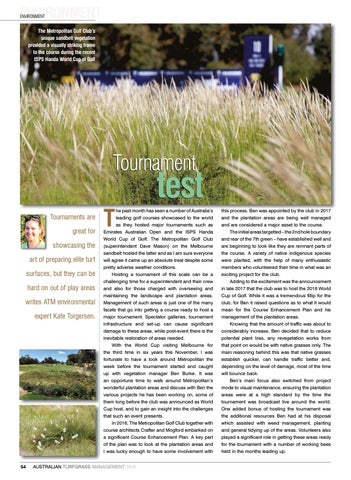ENVIRONMENT ENVIRONMENT
The Metropolitan Golf Club’s unique sandbelt vegetation provided a visually striking frame to the course during the recent ISPS Handa World Cup of Golf
Tournament Tournaments are great for showcasing the art of preparing elite turf surfaces, but they can be hard on out of play areas writes ATM environmental expert Kate Torgersen.
54
T
test
he past month has seen a number of Australia’s leading golf courses showcased to the world as they hosted major tournaments such as Emirates Australian Open and the ISPS Handa World Cup of Golf. The Metropolitan Golf Club (superintendent Dave Mason) on the Melbourne sandbelt hosted the latter and as I am sure everyone will agree it came up an absolute treat despite some pretty adverse weather conditions. Hosting a tournament of this scale can be a challenging time for a superintendent and their crew and also for those charged with overseeing and maintaining the landscape and plantation areas. Management of such areas is just one of the many facets that go into getting a course ready to host a major tournament. Spectator galleries, tournament infrastructure and set-up can cause significant damage to these areas, while post-event there is the inevitable restoration of areas needed. With the World Cup visiting Melbourne for the third time in six years this November, I was fortunate to have a look around Metropolitan the week before the tournament started and caught up with vegetation manager Ben Burke. It was an opportune time to walk around Metropolitan’s wonderful plantation areas and discuss with Ben the various projects he has been working on, some of them long before the club was announced as World Cup host, and to gain an insight into the challenges that such an event presents. In 2016, The Metropolitan Golf Club together with course architects Crafter and Mogford embarked on a significant Course Enhancement Plan. A key part of the plan was to look at the plantation areas and I was lucky enough to have some involvement with
AUSTRALIAN TURFGRASS MANAGEMENT 20.6
this process. Ben was appointed by the club in 2017 and the plantation areas are being well managed and are considered a major asset to the course. The initial areas targetted – the 2nd hole boundary and rear of the 7th green – have established well and are beginning to look like they are remnant parts of the course. A variety of native indigenous species were planted, with the help of many enthusiastic members who volunteered their time in what was an exciting project for the club. Adding to the excitement was the announcement in late 2017 that the club was to host the 2018 World Cup of Golf. While it was a tremendous fillip for the club, for Ben it raised questions as to what it would mean for the Course Enhancement Plan and his management of the plantation areas. Knowing that the amount of traffic was about to considerably increase, Ben decided that to reduce potential plant loss, any revegetation works from that point on would be with native grasses only. The main reasoning behind this was that native grasses establish quicker, can handle traffic better and, depending on the level of damage, most of the time will bounce back. Ben’s main focus also switched from project mode to visual maintenance, ensuring the plantation areas were at a high standard by the time the tournament was broadcast live around the world. One added bonus of hosting the tournament was the additional resources Ben had at his disposal which assisted with weed management, planting and general tidying up of the areas. Volunteers also played a significant role in getting these areas ready for the tournament with a number of working bees held in the months leading up.
